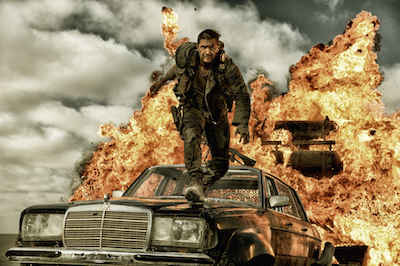 Mad Max: Fury Road is, among other positives, a time machine for film critics of a certain age. A few minutes in and I was back in front of HBO circa 1980 watching the original Max Max (1979), probably for the 100th time. Then I flashed back to me and my dad, who also got into it, at the defunct Rockaway Townsquare Cinema taking in The Road Warrior during that magic summer of 1982; grooving on its kinetic energy, old enough to drive myself to the theater (more sedately than Mel Gibson) I saw it at least twice more. Mad Max Beyond Thunderdome (1985) didn’t really grip anyone’s imagination that strongly, but there I was, too, up to my ankles in Bartertown pig shit and Tina Turner.
Mad Max: Fury Road is, among other positives, a time machine for film critics of a certain age. A few minutes in and I was back in front of HBO circa 1980 watching the original Max Max (1979), probably for the 100th time. Then I flashed back to me and my dad, who also got into it, at the defunct Rockaway Townsquare Cinema taking in The Road Warrior during that magic summer of 1982; grooving on its kinetic energy, old enough to drive myself to the theater (more sedately than Mel Gibson) I saw it at least twice more. Mad Max Beyond Thunderdome (1985) didn’t really grip anyone’s imagination that strongly, but there I was, too, up to my ankles in Bartertown pig shit and Tina Turner.
The gargantuan scale of the new movie takes some getting used it. Thunderdome was much bigger than The Road Warrior, but this is crazy big, and like the imprisoned Max we’re thrown into it. Within minutes we’re en route for the first of several insane desert chases, one interrupted by a colossal sandstorm. It’s a bravura sequence in a movie that doesn’t lack for bravura sequences, and my audience went Mad for it. Yet even hardcore cultists may be slightly bewildered–there’s not much context for all the flourishes just unleashed. Would bigger really be better? Was this to be Max: Mad in the Desert?
But the great George Miller knows how to hook us, and reel us in. Thirty years later Mad Max may not mean all that much to an audience fed a steadier diet of superheroes and fast, furious vehicles, so the film needs to flex its muscles. Layers are gradually added, raising the stakes more each time. By the end, you’re past the edge of your seat, all but levitating with excitement. To paraphrase a line from another 1985 hit, where you’re going, you don’t need roads. What was the late Richard Corliss’ rave review of The Road Warrior headlined? “Apocalypse…Pow!” Fury Road is pow, and now.
Earlier this week I wrote a Mad Max primer for Biography.com, here.
 With tweets coming in droves from 7pm screenings last night, I feel I can’t much add to the superlatives for this continuation. By now you’ve heard it all–that the movie favors practical effects over digital ones, that Charlize Theron leads the female cohort in a storyline that embraces its feminine side (while not stinting on brutish villains who, beyond dressing in mutant punk regalia, go into battle with their own guitarists and percussion sections), that the animalistic cars and trucks, tricked out with all kinds of crazy accessorizing, are more fantastic than ever. What I can add is that while the movie was clearly designed for 3D, the conversion has that dimness around the edges that even a good one like this can’t shake, and I plan to see it again (and maybe again) in 2D. John Seale’s breathtaking images, shot this time in the deserts of Namibia, deserve to be seen as crystalline as possible. (An Oscar winner for The English Patient, Seale came out of retirement for this one.)
With tweets coming in droves from 7pm screenings last night, I feel I can’t much add to the superlatives for this continuation. By now you’ve heard it all–that the movie favors practical effects over digital ones, that Charlize Theron leads the female cohort in a storyline that embraces its feminine side (while not stinting on brutish villains who, beyond dressing in mutant punk regalia, go into battle with their own guitarists and percussion sections), that the animalistic cars and trucks, tricked out with all kinds of crazy accessorizing, are more fantastic than ever. What I can add is that while the movie was clearly designed for 3D, the conversion has that dimness around the edges that even a good one like this can’t shake, and I plan to see it again (and maybe again) in 2D. John Seale’s breathtaking images, shot this time in the deserts of Namibia, deserve to be seen as crystalline as possible. (An Oscar winner for The English Patient, Seale came out of retirement for this one.)
Oh, and while I have some misgivings about Oscars for casting and stunt people, a movie like this silences my objections. I love those regally weathered biddies encountered along Fury Road to the “green place,” women seemingly sprung from the earth. And: those pole vaulters.
Now playing. Revel in what Miller calls “a Western on wheels,” Westward the Women (1951) retrofitted for the future. About Tom Hardy, who spent all of last year’s Locke behind the wheel: firmly in the driver’s seat after Mel Gibson, he’d best get used to it, if more adventures come to pass. I hope they will.





Comments